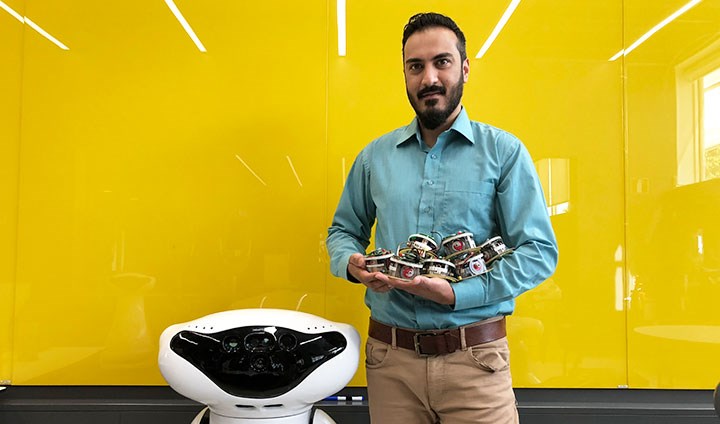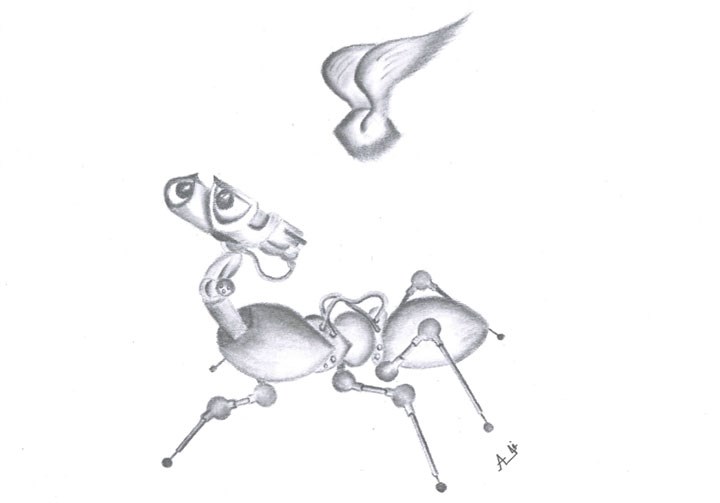Robotics researchers inspired by the navigation skills of ants

Ali Abdul Khaliq publicly defended his doctoral thesis at the School of Science and Technology.
By imitating ants’ behaviour, robots could become less expensive but also more reliable in their navigation, as shown in the doctoral thesis by robotics researcher Ali Abdul Khaliq.
For robots to navigate autonomously, sophisticated sensors that cost a lot of money are currently used. Detailed, complex computations and algorithms are also required to make a robot understand its location, where it is going and how it should get there. The navigation capacity of more inexpensive robots, however, is often too inadequate and therefore they are not very reliable.
“The upscale, complex robots often also suffer with navigation problems,” says Ali Abdul Khaliq, researcher and PhD in computer science at Örebro University.
To get around this problem, Ali Abdul Khaliq was inspired by the way ants navigate in their natural environment.
“Ants and some other insects, like termites, use a principle known as ‘stigmergy’ to navigate. This means that they use their environment as an external memory to store, read and share information,” says Ali Abdul Khaliq.
“Thanks to this principle, ants are able to navigate almost without mistake, completely without the use of sophisticated sensors, powerful computations or even embedded maps.”
Conducted 200 experiments

To find out if this principle can be applied also to robots, Ali Abdul Khaliq has created algorithms for robots and used RFID technology, Radio Frequency ID. RFID technology is used in tags that are read by means of simple radio technology. Today you will find it in for example access cards and security tags on clothing items. Every RFID tag has a memory allowing you to both store and retrieve data using a RFID sensor.
Ali Abdul Khaliq has embedded a network of these tags under floors and then conducted approximately 200 experiments with different types of robots, navigating in the laboratory as well as in a regular apartment using these tags. Some of the experiments went on for hours.
“In one of the trials, a robot was able to navigate autonomously for one kilometre without making a single mistake. That is unusual and difficult to achieve with the technology used today,” says Ali Abdul Khaliq.
Another area explored by Ali Abdul Khaliq concerns the interaction between humans and robots. For robots to perceive and track human movement in its environment, robots are today often equipped with a camera, which could give rise to, for instance, privacy issues. For most existing systems, complex sensor technology is also required in order to guarantee safety.
Avoiding collision
Using RFID technology, Ali Abdul Khaliq was instead able to create algorithms and equip both robot and human with RFID sensors. That way, Ali Abdul Khaliq was able to see the way in which the robot navigated in interaction with the human and how it consistently avoided collisions.
“The experiments went on for several hours and not once did the robot bump into the human,” he says.
Thanks to technology inspired by ants’ navigation method, there is no need for expensive sensors or complex computations, and Ali Abdul Khaliq believes his research will contribute to more frequent use of service robots in the near future – in our homes, at work and in public spaces.
“My approach enables reliable navigation for robots at a lower cost,” says Ali Abdul Khaliq.
Text and photo: Anna Lorentzon
Translation: Charlotta Hambre-Knight
Ali Abdul Khaliq publicly defended his doctoral thesis at the School of Science and Technology. Title of the thesis: From Ants to Service Robots: an Exploration in Stigmergy-Based Navigation Algorithms.
